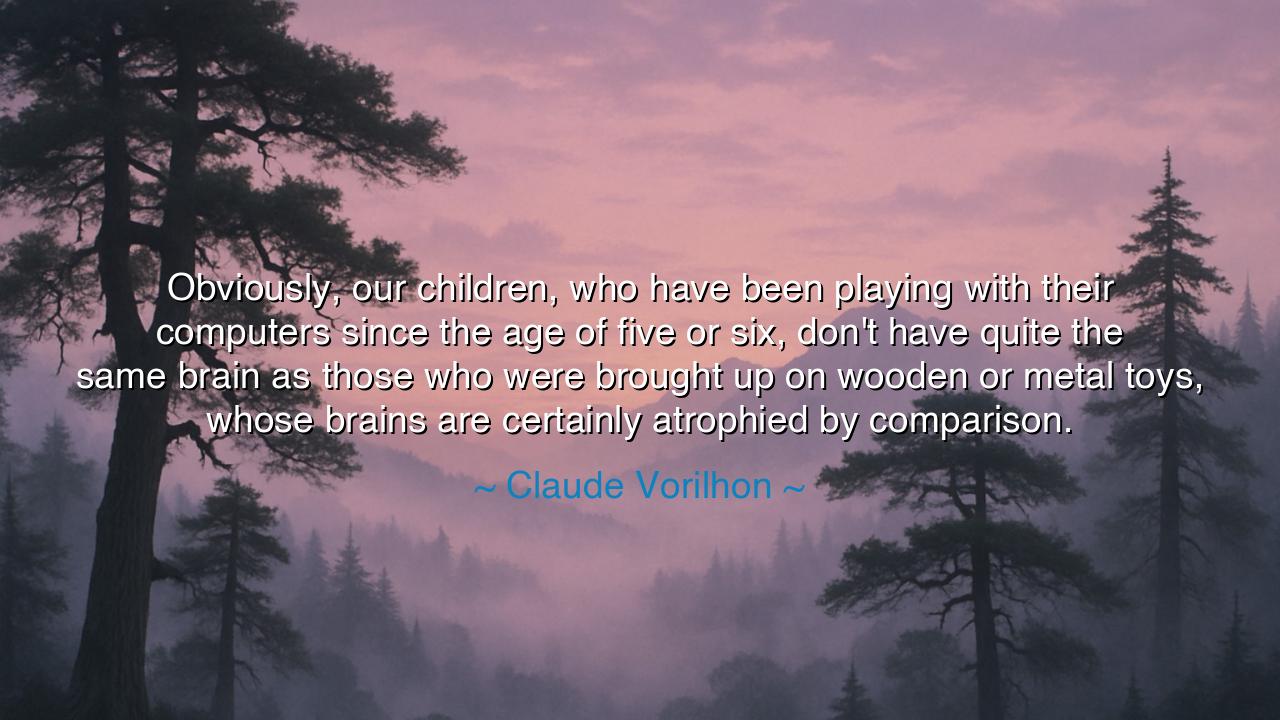
Obviously, our children, who have been playing with their
Obviously, our children, who have been playing with their computers since the age of five or six, don't have quite the same brain as those who were brought up on wooden or metal toys, whose brains are certainly atrophied by comparison.






Claude Vorilhon — later known as Raël — uttered this striking observation in an age trembling before the rise of the digital child: "Obviously, our children, who have been playing with their computers since the age of five or six, don't have quite the same brain as those who were brought up on wooden or metal toys, whose brains are certainly atrophied by comparison." His words pierce more deeply than mere technological nostalgia. They speak to the eternal struggle between evolution and tradition, between the mind molded by innovation and the one anchored in the past. Vorilhon saw that every generation reshapes the human brain — not metaphorically, but biologically — through the tools it wields and the worlds it imagines.
In the old days, children’s hands shaped the world of wood and metal; their imagination was confined to the tangible, the weight of real things, the resistance of matter. But in the digital age, children’s minds dive into realms of infinite code and light — places where logic and fantasy interlace with seamless speed. The computer, to Vorilhon, was not merely a toy, but an extension of consciousness, a new mirror for human thought. When he says the older brain is “atrophied,” he does not mean lesser in worth, but slower in adaptability. The child of circuits perceives patterns beyond the reach of the craftsman’s hammer, for every new medium births a new way of seeing, thinking, and being.
Consider the story of Alan Turing, the father of modern computing. In his childhood, he played not with machines of circuits but with puzzles and chemistry sets — yet his mind saw patterns in symbols and logic, perceiving the invisible beneath the visible. His brain — much like those of today’s youth — was rewired by abstract thought. And through that, he gave birth to the concept of the “machine mind,” the very foundation of the computers that now shape children’s cognition. Thus, what Vorilhon foresaw is not degeneration, but transformation — the perpetual metamorphosis of the human mind through its tools.
Yet, there lies in his tone a warning — one wrapped in paradox and provocation. The wooden and metal toys of the past taught patience, touch, and the weight of effort; the computer toys of today teach speed, simulation, and instant gratification. One nurtures craftsmanship; the other cultivates imagination unbound by substance. Both are sacred paths of learning, yet each risks losing something of the other. The challenge for our age is not to lament the digital child, nor to glorify the tactile past, but to find harmony between matter and mind, craft and code.
Look to Japan’s story for guidance. In the postwar years, the nation blended the soul of ancient artisanship with the dawn of robotics. The engineers of Toyota and Sony were not only programmers but poets of precision, heirs of the blacksmith and the monk. They built machines with the same reverence their ancestors carved temples — merging human warmth with digital mastery. In doing so, they proved that the future belongs not to the digital brain alone, but to the balanced spirit — one that honors the hand as well as the mind.
The deeper meaning of Vorilhon’s words, then, is not disdain for the old, nor blind faith in the new, but a call to evolution through awareness. Every generation must look upon its inventions not as idols, but as mirrors. A brain shaped by wood knows structure; a brain shaped by code knows infinity. The wise heart seeks both — grounding imagination in creation, and creation in imagination.
The lesson is this: Do not fear the changing brain. Fear only the unconscious brain — the one that evolves without understanding itself. Let children of light learn from the patience of wood; let craftsmen of metal learn from the boldness of circuits. Between the weight of matter and the dance of data, humanity will find its next rebirth.
Practical actions for the modern soul:
-
Encourage children to both build with their hands and dream with their code.
-
Teach the young that every click has consequence, every design reflects mind.
-
Balance time in the digital with moments of tangible creation — painting, gardening, crafting.
-
Honor both the ancient craftsman and the child of algorithms as carriers of the same human flame.
For as Vorilhon implies, evolution is not a war between ages — it is a dialogue between minds, from wood to wire, from earth to ether, from man to the infinite.






AAdministratorAdministrator
Welcome, honored guests. Please leave a comment, we will respond soon